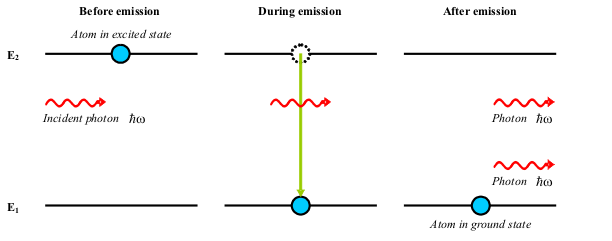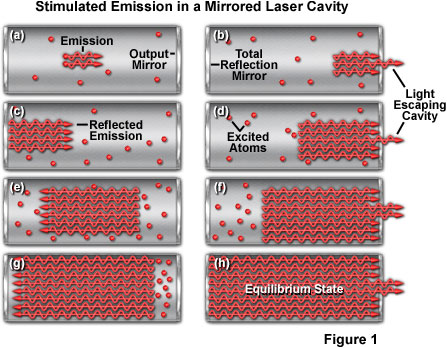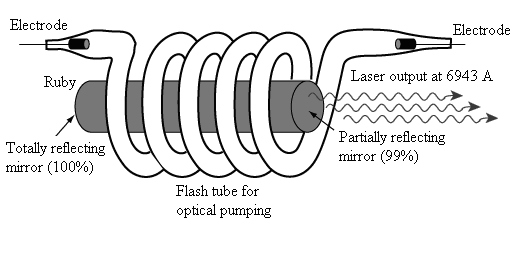HOW
A
LASER WORKS
The
laser
begins at the atomic level, and more specifically with the electron.
When
an electron becomes energized, it jumps to a higher level within the
atom's
structure. In a normal atom, all of the electrons fill the lowest
energy states
possible, and thus want to drop from an energized state to a base
state. When
an electron drops from a higher, energized state, it emits a photon as
a byproduct.
Lasers themselves are large groups of photons focused into a beam, but
getting
from a randomly moving photon generated from an electron to a nice beam
is no
easy task. From here, stimulated emission comes in.
 An example of stimulated emission.
An example of stimulated emission.
Image Credit:
http://physics.schooltool.nl/quantumoptics/images/content/emission.gif
Stimulated
emission works like an amplifier. If we take a system
with a large amount of atoms that have electrons in high energy states,
the
electrons will want to come down from those states into a lower one.
Doing so
emits a photon of a certain wavelength, depending on which energy state
the
electron began in and which state it dropped to. In order to get an
electron to
drop from a high state to a low one, we can make it interact with an
electromagnetic wave, or another photon! Under the hood is a quantum
process
that allows us to essentially put in one photon and get two out of the
exact
same wavelength. This is our "stimulation" portion of Einstein's
theory. When another photon interacts with the electron with a high
energy
atom, the electron will drop and emit two photons. This is our
"emission".
The entire process gives us an amplification of photons that can be
used for
our laser.
 Diagram illustrating how photons are "aligned" and allowed
through.
Image Credit:
http://www.olympusfluoview.com/java/stimulatedemission/index.html
Diagram illustrating how photons are "aligned" and allowed
through.
Image Credit:
http://www.olympusfluoview.com/java/stimulatedemission/index.html
But
wait,
how do we get our electrons to get energized in the first place? The
answer: Flash Tubes. These tubes act as a "pump" to start driving the
atoms in our lasing medium. They emit extremely intense bursts of light
in very
short amounts of time, and this full spectrum light energizes the laser
medium.
As stated before, now that we have energized electrons, we can get
photons! Once
the laser medium begins emitting photons, they need to be focused and
lined up
in order to establish our beam. To do this, we look to the physical
structure
of our laser.
 A flash tube wrapped around a laser medium
A flash tube wrapped around a laser medium
Image Credit:
http://www.indiastudychannel.com/attachments/Resources/129632-25051-untitled1.bmp
Thomas
Edwards
-
Physics
212x
- F05 - 2011



